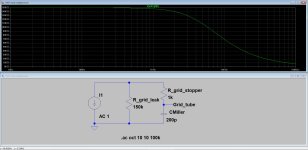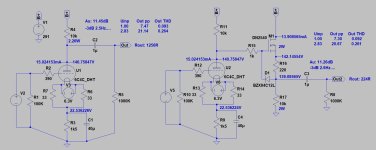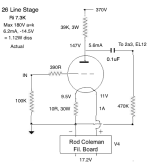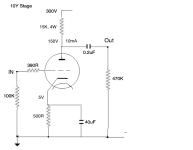If you put the vol to max you can read the input impedance resistive and capacitive working with the input signal and frequencyThe link states that for a grounded cathode stage Zin = Rg || Zmiller
And Zmiller coming out at mid high frequency
One of the test we do is to put the volume to -6dB ( half value) then measured the frequency response
In some case it is down too early due the Miller effect coupled with a mid-high value of pot
Walter
It is not influentthe grid stopper is 1k
At 10kz the 200 pf has 80kohm of Z
And 40kohm at 20 khz
Walter
If you put a 10k pot as volume control in front of a tube power amp with a 150k grid leak resistor, the 10k ohms of the volume control will now be in parallel with the 150k grid leak resistor. The input impedance (at midband, anyway) would then be 10k || 150k = 9.375k ohms, no?
Tube is voltage device.
It is essential to have high voltage.
And closed boxed (or rounded) anode.
and lower mju factor one digit pref.
These are more important 3 conditions.
biasing voltage higher than heating voltage too.
.
lower Ri is additional but less importatant.
.
So from high voltage, boxed anode 10Y, 801A etc are top ones.
307A, 1619, 1624 ets are good too.
.
But
2A3, 6B4G are maybe the best choice with high voltage, boxed anode, low Ri, high abs(-Ug), low -A, and linearity...
inclouding all contemporary single anode versions based on 2A3 characteristics.
.
Again
All of these high current, very low Ri tubes has wide OPEN anodes, with "fireworks" outside of plate and very low voltages.
The sound outcome from these tubes simply could not be compared with for instance 2A3 tube in preamp mode.
It is essential to have high voltage.
And closed boxed (or rounded) anode.
and lower mju factor one digit pref.
These are more important 3 conditions.
biasing voltage higher than heating voltage too.
.
lower Ri is additional but less importatant.
.
So from high voltage, boxed anode 10Y, 801A etc are top ones.
307A, 1619, 1624 ets are good too.
.
But
2A3, 6B4G are maybe the best choice with high voltage, boxed anode, low Ri, high abs(-Ug), low -A, and linearity...
inclouding all contemporary single anode versions based on 2A3 characteristics.
.
Again
All of these high current, very low Ri tubes has wide OPEN anodes, with "fireworks" outside of plate and very low voltages.
The sound outcome from these tubes simply could not be compared with for instance 2A3 tube in preamp mode.
The 10Y or 801A are the best preamp tubes I've built with. I don't think you can get a better choice except maybe 45 which I've never owned.
But from the short time I've had with the 6C4C I would put it up there with the best, including 26. I need to try out different circuits with it and see how I can optimise it. Early days, but I like what I hear.
But from the short time I've had with the 6C4C I would put it up there with the best, including 26. I need to try out different circuits with it and see how I can optimise it. Early days, but I like what I hear.
26 is very good at vocals but 801A is other beast.
Never tried 6C4C, I'm curios about how it sounds compared vs 26, 801A & 4P1L?
Never tried 6C4C, I'm curios about how it sounds compared vs 26, 801A & 4P1L?
Last edited:
I had a listening session with my buyer for a DIY preamp. We listened to his Korg preamp, the 6C4C and a 26 stage. The Korg was the least interesting. In the end the 26 came out ahead because of the superior tonal quality, though there was more detail with the thinner sounding 6C4C. But given the requirement of an output impedance around 1K we agreed that the best choice would be a 10Y stage with a step-down output transformer. I don't have one built but I've built 10Y stages before so I know how to put it together and I have a pair of LL1660/18mA. The 10Y comes out on top once again.
26 sounds better with Ale's hybrid mu-follower than with LL1660....
If you use OPT have to be high quality or you lose tone, other drawback it's you lose gain...
If you use OPT have to be high quality or you lose tone, other drawback it's you lose gain...
Merlin - do you have experience with Ale's Source Follower as an alternative to the mu-follower?
If you're open to using indirectly heated tubes you might consider using the "output" section of one of the tubes that are typically used in spud amps. Mu of ~5.5 and a plate resistances of 750 to 920 ohms.
SF isn't alternative to high impedance anode loading (for example CCS, gyrator or large anode choke).Merlin - do you have experience with Ale's Source Follower as an alternative to the mu-follower?
It's guaranties lower output impedance, larger driving capacity, better slew rate, but adds almost nothing to tube's load problem.
Hello Bela - what do you perceive as the "tube's load problem"? I like the sound of resistor loads - they are a classic choice and haven't been a "problem" for all the designs that use them. Some like an active load, I prefer the sound of resistors.
But yes, for tubes like 26 and 10Y I need to lower the output impedance. I was gong to use a step-down transformer but if a source follower sounds as good I'm open to trying that. I have a pair of Ale's V01 SFs but I have no instructions for how to set them up. Can anyone explain how to set up this SF and how much it lowers the output impedance? I know very little about solid state stuff.
But yes, for tubes like 26 and 10Y I need to lower the output impedance. I was gong to use a step-down transformer but if a source follower sounds as good I'm open to trying that. I have a pair of Ale's V01 SFs but I have no instructions for how to set them up. Can anyone explain how to set up this SF and how much it lowers the output impedance? I know very little about solid state stuff.
Last edited:
Yes indeed. I've built with all of these DHTs plus the 27 so I already covered that ground. I was looking on Bartola for a manual for the source follower but I couldn't see one.
My question about tube + sand is why use this mix?
On link is possible to see tht, p.e., for VT25 tha output of gyrator goes to a divider to fix the point of the fet but it also act as attenuator of signal.
Same for other types
For 300B the Va is 190 Vdc and 30 mA of Ia ; the Rk is not bypassed so the Zout is increased
Strange approach for me
Walter
On link is possible to see tht, p.e., for VT25 tha output of gyrator goes to a divider to fix the point of the fet but it also act as attenuator of signal.
Same for other types
For 300B the Va is 190 Vdc and 30 mA of Ia ; the Rk is not bypassed so the Zout is increased
Strange approach for me
Walter
Good question, Walter. I only use whatever solid state devices I have to use, one good example being Rod Coleman filament regs. Otherwise I try and avoid solid state, because I have no working knowledge of solid state and it's a pain for me to have to look up all kinds of instructions and tutorials to use the stuff. Easy for most, but I just taught myself to use tubes and I'm not going to learn solid state at this late stage - I'm retired.My question about tube + sand is why use this mix?
Walter
The project with 6C4C is for the guy who has a EAR amp with approx. 10K input impedance. So I need a Z out of 1K. Otherwise I don't need it for my own system. That's fine. This is just a special order. Somebody has to build DHT preamps since you can't buy them commercially except for silly money. I would be using 26 or 10Y, whatever I can get down to 1K and still have some gain.
- Home
- Amplifiers
- Tubes / Valves
- Low Rp tube for line stage - ideas?



